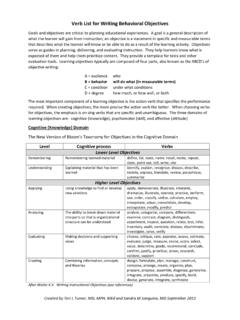Transcription of Managing Neonatal Hypoglycemia.pptx - Read-Only
1 3/8/20181 Managing Neonatal Hypoglycemia: Can formula supplementation be avoided?Shawnte R. James, MD, FAAPA ssistant ProfessorNewborn Medicine HospitalistEmory University School of MedicineDepartment of PediatricsDivision of Neonatal -Perinatal MedicineFaculty Financial Disclosures In accordance with the ACCME standards for commercial support, all faculty members are required to disclose to the program audience any real or apparent conflict(s) of interest to the content of their presentation. I have nothing to 1 Baby Carlton is an early term newborn ( weeks) who was delivered by STAT C/S after loss of fetal heart tones.
2 His APGARs were 6/9/9, he is AGA. He arrives in the holding nursery at 45 minutes of life, and his initial glucose is 44. Because of the STAT C/S, his mother was under general anesthesia for the delivery. What is the most appropriate next step in the management of Baby Carlton?A. No supplementation, await mother s availability for S2S and breastfeedingB. No supplementation and immediately have L+D nurse hand express mother s colostrum to feed to babyC. No supplementation and recheck sugar in 1 hourD. Supplement with 5-10mL of formula via cup or syringeE. Supplement with bottle/nipple to feed to satisfaction3/8/20182 Case 1 AnswerHow do we define hypoglycemia?
3 How do we define hypoglycemia?3/8/20183 Case 1 (If you re curious, here s what I would choose)Baby Carlton is an early term newborn ( weeks) who was delivered by STAT C/S after loss of fetal heart tones. His APGARs were 6/9/9, he is AGA. He arrives in the holding nursery at 30 minutes of life, and his initial glucose is 44. Because of the STAT C/S, his mother was under general anesthesia for the delivery. What is the most appropriate next step in the management of Baby Carlton?A. No supplementation, await mother s availability for S2S and breastfeedingB.
4 No supplementation and immediately have L+D nurse hand express mother s colostrum to feed to babyC. No supplementation and recheck sugar in 1 hourD. Supplement with 5-10mL of formula via cup or syringeE. Supplement with bottle/nipple to feed to satisfactionEndocrinology Plasma glucose concentration low enough to cause signs of symptoms of impaired brain function. If unable to communicate symptoms, PG levels below the normal threshold for neurogenic responses <60 mg/dL(< mmol/L)Merck Manual of Diagnosis and Therapy Plasma glucose concentration < 40 mg/dL(< mmol/L) in term neonates or < 30 mg/dL(< mmol/L) in preterm neonates3/8/20184 American Academy of PediatricsAmerican Academy of Breastfeeding Medicine A reasonable (although arbitrary) goal is to maintain plasma glucose concentrations between 40 and 50 mg/dL(between mmol/L) Acceptable and stable value of >40 mg/dL(> mmol/L)How do we define hypoglycemia?
5 TAKE HOME POINT:The definition of Neonatal hypoglycemia in the first 48hrs of life for term and late preterm newborns remains one of the most contested and controversial topics in Neonatal /Perinatal Hartmann, MD and Joseph Jaudon, MD (1937) ..the frequent occurrence newborn infants of cyanosis, irritability, listlessness and muscular very well be due sometimes to hypoglycemia..is almost a normal occurrence during the first few days of life. Heather J. Shelley, (British Medical Bulletin, Jan 1966)Intrauterine Glucose Principal energy substrate for placenta and fetus Needs to be kept relatively constant to ensure steady growth of fetus Levels controlled by three mechanisms.
6 Maintenance of maternal glucose concentration Transfer of maternal glucose to fetus through placenta Production of insulin by the fetal pancreas3/8/20186 Fetal oxidation of intrauterine glucose Regulated by glucose transporters (GLUT4) in the insulin sensitive tissues (tissues with IR s) Up or down-regulated in response to changes in fetal glucose concentration RATE is dependent on the relative interaction between two components: Fetal plasma glucose Fetal insulin concentrationRegulation of glucose metabolism by (99)00201-5 Glucose in the healthy newborn Decreases by 25-35mg/dLin the first 2-3 hours of life Reaches a nadir at ~3hrs of life Steadily increases to reach normal levels in 24-48hrs3/8/20187 Clinical Hypoglycemia Serum glucose concentration low enough to cause symptoms and or signs of impaired brain function.
7 Symptoms Autonomic Adrenergic Palpitations, tremor, anxiety Cholinergic Sweating, hunger, paresthesia Neuro-glycopenic Brain fog Confusion ComaHow does exclusive breastfeeding affect a newborn s glucose? Exclusively breastfed infants do not receive full caloric intake for several days after birth, resulting in hypoglycemia. Ketogenesisis partially activated, but measured ketones in Neonatal serum in the first days of life are low ( )Are ketones an acceptable alternative fuel source for neonates in the first 24-48hrs of life? Without specific measurement of ketone levels during the period of hypoglycemia in question, it CANNOT be assumed ketones are available and sufficient to support brain metabolism.
8 It CANNOT be assumed that ketones will protect brain metabolism in a breast-fed infant if post-natal fasting state/hypoglycemia is what should we do?!So what should we do?!(I m kidding, I actually know what we should do this time)So what should we do?!3/8/20189 How to effectively increase glucose concentration in hypoglycemic neonate? Intravenous dextrose fluids PO feeds with EBM or for bonus points?How to effectively increase glucose concentration in hypoglycemic neonate? Intravenous dextrose fluids Volume PO for bonus points?ORAL DEXTROSE GEL!!! 3/8/201810 Actually, more like this, but close!
9 Implementing a Protocol Using Glucose Gel to Treat Neonatal Hypoglycemia. (Bennett, Fagan, et. al.)Abstract Neonatal hypoglycemia is a leading cause of admission of neonates to the NICU. Typical treatment for Neonatal hypoglycemia includes supplementation with formula or, in some cases, intravenous glucose administration. These treatments, though effective at treating hypoglycemia, interrupt exclusive breastfeeding and interfere with mother-infant bonding. Our institution developed a treatment algorithm for newborns at risk for Neonatal hypoglycemia. The new algorithm called for the oral administration of 40% glucose gel.
10 This intervention resulted in a 73% decrease in admission rates to the NICU for hypoglycemia, and it supported exclusive breastfeeding, skin-to-skin contact, and mother-infant bonding. (15)00002-1/fulltext Basic steps in glucose gel algorithm Neonates are placed skin to skin and breastfed within the first hour of life. A BG level is obtained 30 minutes after this feeding is completed. If the BG level is <35 mg/dl, the nurse administers a weight-based dose of 40% glucose gel by syringe to the neonate s buccal cavity and then places the neonate with the mother to feed.






